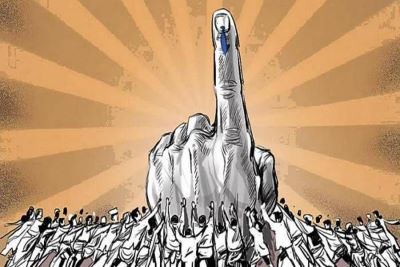Context
Despite opposition from political parties and civil society regarding simultaneous elections, the Union government has decided to implement the recommendations of a high-level committee led by former President Ram Nath Kovind. The committee proposes conducting Lok Sabha and State Assembly elections together, followed by municipal and panchayat polls within 100 days of the general elections. To implement this plan, the government will need to secure constitutional amendments in both Parliament and State Assemblies.
Overview
The first General Elections for the House of People (Lok Sabha) and all State Legislative Assemblies took place simultaneously in 1951-52. This practice continued for the next three General Elections held in 1957, 1962, and 1967. However, the cycle was disrupted due to the premature dissolution of several Legislative Assemblies in 1968 and 1969.
Justification for the proposal
Two main justifications have been cited for this proposal
First: conducting elections simultaneously would significantly reduce costs; second: the lack of simultaneous elections keeps political parties in a constant state of campaigning, negatively affecting governance and legislative productivity. However, there is little empirical data to support the cost reduction claim.
Potential benefits of simultaneous elections for India
- Lower Election Expenses: Conducting elections simultaneously can significantly lessen the financial burden on both the government and political parties by reducing the overall costs linked to organizing multiple elections at different times.
- Streamlined Processes: Holding elections at the same time allows for better utilization of administrative resources, alleviating the strain on electoral machinery and personnel, which often face challenges during staggered elections.
- Minimized Election Cycles: Simultaneous elections can shorten the period of election-related campaigning, enabling elected representatives to focus more on governance instead of being in continuous campaign mode.
- Stability in Administration: Frequent elections can disrupt effective governance. By holding simultaneous elections, governments can enjoy more stable terms, resulting in consistent policy implementation and improved service delivery.
- Higher Turnout Rates: A unified election process may boost voter turnout, as citizens are more likely to engage when multiple elections occur together, potentially enhancing civic participation.
- Clearer Mandates: When elections take place concurrently, voters can assess candidates and parties with a comprehensive understanding of their performance, promoting greater accountability among elected officials.
- Unified Political Landscape: Simultaneous elections could encourage a sense of national unity and coherence, as voters across various states participate in the electoral process at the same time.
- Decreased Tensions: Staggered elections can heighten political tensions and conflicts. Conducting elections simultaneously may help mitigate these risks by consolidating the election period.
Challenges to simultaneous elections for India
- Need for Legal Reforms: Implementing simultaneous elections necessitates substantial constitutional amendments, which may encounter opposition in both Parliament and State Assemblies. Garnering consensus among a diverse range of political parties is a significant obstacle.
- Impact on State Governments: Synchronizing elections may require the premature dissolution of several state governments, raising concerns about the erosion of federalism and state autonomy, potentially leading to political instability.
- Diverse Electoral Calendars: Different states operate on varying electoral cycles, with some facing early dissolution. Aligning these diverse timelines into a cohesive electoral schedule may compromise democratic integrity.
- Strain on Electoral Machinery: Although simultaneous elections aim to enhance efficiency, the scale of managing multiple elections simultaneously could overwhelm administrative resources, increasing the risk of logistical failures and electoral mismanagement.
- Differing Priorities: Voter interests and concerns vary significantly across regions and governance tiers. A simultaneous election may dilute attention on local issues, potentially leading to voter apathy and decreased engagement.
- Complicated Campaign Strategies: Political parties might find it challenging to develop effective campaign strategies that address the distinct concerns of various electoral tiers at once, possibly resulting in a generalized approach that fails to resonate with voters.
- Heightened Risks: Conducting multiple elections simultaneously could escalate the risks of election-related violence and security issues, especially in politically unstable regions, complicating effective security management.
- Resistance from Stakeholders: Significant pushback from political parties and civil society organizations poses a challenge. Concerns regarding the potential impact on democracy and representation may impede public acceptance of this proposal.
Way ahead
- Engage Stakeholders: Launch an inclusive dialogue that brings together political parties, civil society, and electoral experts to discuss concerns and foster consensus on the necessity of simultaneous elections.
- Draft Amendments: Develop precise constitutional amendments to enable simultaneous elections, ensuring they protect federalism and the autonomy of state governments.
- Conduct Pilot Projects: Roll out pilot programs in select states to evaluate the feasibility and effectiveness of simultaneous elections, allowing for modifications based on real-world findings.
- Enhance Administrative Capacity: Focus on boosting the efficiency and capability of the electoral machinery to handle the complexities of conducting multiple elections at the same time.
- Increase Awareness: Implement educational campaigns aimed at informing voters about the advantages and processes of simultaneous elections, highlighting the significance of local issues alongside national ones.
- Establish Clear Guidelines: Develop a strong legislative framework that details the procedures for synchronizing elections, including mechanisms for addressing mid-term elections and unforeseen dissolutions.
- Develop Comprehensive Security Plans: Work with law enforcement to create enhanced security strategies to address the challenges posed by conducting multiple elections simultaneously.
- Monitor and Review: Set up systems for ongoing evaluation and stakeholder feedback post-implementation to identify challenges and opportunities for improvement.
Conclusion
While simultaneous elections in India offer potential advantages like cost savings and improved governance, notable challenges persist, including the necessity for constitutional reforms and the management of varied electoral timelines. A collaborative strategy that includes stakeholder engagement, pilot projects, and strong administrative backing is crucial for effective implementation.
|
Probable questions for upsc mains exam 1. What measures can be taken to ensure that local issues are not overshadowed in a simultaneous election scenario? Discuss the importance of maintaining focus on regional governance. 250 words (15 marks) 2. Critically evaluate the arguments for and against simultaneous elections. In your opinion, do the advantages outweigh the challenges? Justify your stance.150 words (10 marks) |
Source: The Hindu







